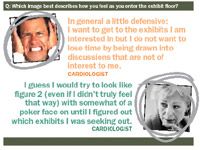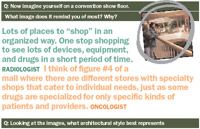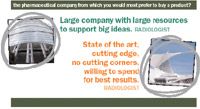Agency Best Practice in Regulatory Compliance
Pharmaceutical Executive
NO ONE REALLY KNOWS WHAT A DOCTOR IS thinking most of the time, and those of us who are patients can be happy about that. We are comforted when physicians keep their counsel until they complete an examination.
NO ONE REALLY KNOWS WHAT A DOCTOR IS thinking most of the time, and those of us who are patients can be happy about that. We are comforted when physicians keep their counsel until they complete an examination.
But that physician's poker face is no help to exhibitors who meet doctors at medical conferences. On the outside, they smile and shake hands, but the thoughts and feelings they withhold can tell a very different story.

A focus group convened by Impact Unlimited, an events, exhibits, and meetings company in Dayton, NJ, sought to understand doctors' attitudes toward conferences, exhibit halls, and pharma companies. Thirty high-prescribing doctors participated in the study, including radiologists, oncologists, neurologists, cardiologists, and primary care physicians, all of whom attended at least one national convention in their medical specialty in the last two years.
Focus group facilitators showed these doctors arrays of photographs and asked to pick the image that best portrays their attitude, and then to explain why that picture of a car or building expresses their feeling better than others. The result? A rare glimpse into why physicians attend medical conferences and what they like— and don't like—about them. The results also provide an opportunity to understand the emotional and psychological motives behind trade show participation, and offer lessons for pharma companies in how to connect more effectively with doctors during face-to-face interactions on the exhibit hall floor.

Overwhelming Displays
So what do physicians really think as they walk the show floor aisles? The focus group showed doctors nine photographs of facial expressions and asked them to point to the image that best describes how they feel as they enter the exhibit floor at a conference.
If you imagined it was the ecstatic bliss of number A5 or the happiness, even delight, of A4 or A8, well, think again. Among the respondents, 10 doctors chose photo A3, the man holding his ears and clenching his teeth in agony of the apparent sensory overload. And another seven physicians chose number A2, the one they thought of as the "poker face."
"I am always overwhelmed by the exhibit hall," one radiologist said. "It is so confusing [to know] where to start, how to figure out if I've missed anything, and where to go next with your limited time ... it's a feeling of, 'Oh my God, how am I going to figure out what's happening here? What have I gotten myself into?'"

During the physician focus group, one word popped up again and again: "overwhelmed." Most healthcare professionals described the exhibit floor as an exaggeration of the marketing onslaught they experience in their daily lives—sales visits, DTC advertising, targeted print and Internet marketing—only taken to the max.
When exposed to that volume of information, doctors seem to respond much they way they do in their offices—by shortening face-time with reps. Most conference attendees spend only about four minutes per booth.
To make that time more valuable for doctors and sponsors, exhibitors should strive to present one consistent, memorable, integrated message. All components—including booth design, presentations, promotional materials, and reps' discussions with physicians—need to work together to deliver a uniform, simple message. Companies should ensure sales reps' training allows them to deliver that message, and that the take-aways are ready to go.
"Ready to go," does not mean chomping at the bit. Pharma reps must learn not to control those four minutes. Instead, most physicians want to engage with reps on their own terms, and control their own pace.
Disengaged Doctors
Some doctors have made an artform out of avoiding sales representatives. In the focus group discussion, physician respondents even admitted that they consciously walk down the middle of the aisle between booths to avoid being drawn into unwelcome or long-winded conversations with overeager pharma reps.
"Show that you can solve my problems or my patients' problems with your product, or that you can make my job easier," a primary care physician said in the focus group. "No hard sell. Just say what your product can do, and then offer just bullets of evidence, unless I request more. My brain is almost full, and I don't want anything more than what I absolutely must know."

On the crowded exhibit hall floor, less is more. In fact, one way companies can attract more physicians and hold their attention longer is to create a "no detail zone" at the booth, an area where doctors can meander, greet colleagues, and review information—without being approached by a rep.
This gives physicians time to take things in and decide, on their own, if they want more information. Without the pressure of a rep—or reps—following the doctor's every step, physicians might spend even more time at the booth investigating its resources than they otherwise would.
But it's not only the design of the booth that counts, said focus group participants. Companies can create more effective exhibits if they think carefully about the environment their booth represents, and how it fits into the convention floor as a whole. Healthcare professionals were shown photos of six different environments, and asked to identify which most reminds them of the convention show floor. Just three were reminded of a placid college campus. Four thought of a carnival midway, and eight felt it resembled a big-city traffic jam. Maybe the pace is a little frantic for some physicians!
But 10 doctors chose a shopping mall, indicating that medical conventions provide a one-stop shop for browsing and comparing various drugs, devices, and equipment.

"At a mall, there are different stores with specialty shops that cater to individual needs," one oncologist said. "Just as some drugs are specialized for only specific kinds of patients and providers."
Freebies Still Popular
Doctors perceive several downsides to visiting the exhibit floor, but they agree that trade shows, on the whole, still offer them invaluable opportunities. Respondents agree that certain convention traditions, like networking opportunities and informative presentations, keep them coming back for more.
This is particularly true for give-aways. Physicians love freebies. The proof: Doctors making six figures will wait in long lines for a free pen.
"Physicians have been trained into this behavior during medical school and residency," one doctor said, wryly. "Drug reps fed us and gave us pens and other toys when we were starving students. Old habits die hard." But the doctor participants mentioned there was room for improvement—they said they wanted premiums with real value.
The focus group said that company logos and overt branding often ruin high-value items. In these cases, consider stealth branding. Put a logo on the inside cover of a personalized journal instead of plastering it on the front.
"A company may give out a nice leather-bound product, but with a big imprinted logo," said a neurologist. "The logo often makes it worthless for general use. They should save their money for better purposes."
Free food and beverages also have great appeal, the physicians said, because they're going to have to buy those items anyway. However, instead of snacks and soda, help conference attendees avoid crowded convention-center cafes by offering "real" food. In fact, in Europe, it's not surprising to find full restaurants inside the exhibits, which encourage attendees to linger, and engage in deeper conversations.
What's in a Car?
The image of a company is projected through its presence at the exhibit hall. Style your booth to doctors' images of a good partner or vendor. But what should the exhibit look like?
In the focus group, participants were shown photographs of nine automobiles and asked which car best represented the pharma company they would most prefer to do business with. Glitz and glamour did not carry the day.
Sports cars fared less well than an SUV and a sedan, which tied with seven votes apiece. Respondents prefer to work with pharma companies considered safe, reliable, and mature, with proven track records.
"The SUV," said one radiologist, "evokes the feeling of power, but it is not too flashy, seems solid, and has the ability to take you to new places."
Five doctors chose the Hummer, which supported the Big Pharma model. "Big companies with a solid sales force and immense resources support physicians," said one radiologist.
Stop Traffic
Traffic at the booth matters. One great traffic-boosting technique for companies: partner with a medical equipment vendor, ideally one that complements your drug. For example, if you're marketing a hypertension drug, offer testing from a real-time hypertension monitoring device to capture interest and reinforce your drug's indication.
Conferences are often the first chance for doctors to see the latest medical equipment and technology. Conventions offer the opportunities to compare equipment—"kick the tires," so to speak—whereas doctors have other sources for pharma information: the Web, medical journals, sales reps, and TV ads. Indeed, physicians in the target group said they'll often bypass pharma booths in favor of getting some hands-on time with the latest medical gear.
"I like to window shop the new technology," said a radiologist. "Sometimes I have a specific item I need to research, and I like having the opportunity to compare things in real-time by walking the floor from vendor to vendor and going back and forth."
Perhaps it's the cutting-edge technology that represents an ideal in physicians' minds. When shown photos of 10 buildings, participants were asked what architectural design best represents the pharma company from which they would most like to buy a product.
Nearly all respondents voted for one of three photographs. Six went for avant-garde modernism, perhaps a vision of first-in-class research. Nine chose an opulent resort building with a blue swimming pool and broad shady balconies. But the largest number, 10, chose a contemporary glass-and-steel skyscraper. Interpretation: a state-of-the art company, with ample resources to support new research and ideas.
"The skyscraper is nice, elegant-looking, and appeared serious and well-presented," a cardiologist said. "It represents a large company with large resources to support big ideas," a radiologist added.
What Succeeds
Clearly, conventions succeed on a fundamental level or they wouldn't attract physicians. When the doctors were asked if conference exhibits change or influence their prescribing habits, their answer was overwhelmingly "yes."
"The name of the product is fresh in my mind," one cardiologist said. "If the information is reinforced by [a] seminar or lecture, I can be converted to a new product."
But the perfect formula for pharma marketing success at conventions isn't etched in stone. Innovative marketers can stand out and attract greater traffic, and reach larger numbers of high-prescribing, influential physicians.
Healthcare professionals who can enjoy a no-detail-zone, get high-value freebies, and low-pressure sales representative interaction at exhibits or booths are more likely to change their overall impression—and prescribing behaviors. And they may desire to return next year.
Pharmaceutical marketers who construct a well-rounded conference presence will fare far better than those companies that simply lock-and-load a snappy display on the show floor. More and more, physicians are demanding substance over style.
"When the patient benefits from good medicine and marketing, then everyone wins," said one of the focus group's primary care physicians.
FDA Outlines Updated Requirement for Placebo-Controlled Trials in Vaccine Research
May 21st 2025In an article recently published by The New England Journal of Medicine, FDA higher-ups Vinay Prasad, MD, MPH; and Martin A. Makary, MD, MPH, wrote that any new COVID-19 vaccine must now be evaluated in placebo-controlled studies.
Addressing Disparities in Psoriasis Trials: Takeda's Strategies for Inclusivity in Clinical Research
April 14th 2025LaShell Robinson, Head of Global Feasibility and Trial Equity at Takeda, speaks about the company's strategies to engage patients in underrepresented populations in its phase III psoriasis trials.
Beyond the Prescription: Pharma's Role in Digital Health Conversations
April 1st 2025Join us for an insightful conversation with Jennifer Harakal, Head of Regulatory Affairs at Canopy Life Sciences, as we unpack the evolving intersection of social media and healthcare decisions. Discover how pharmaceutical companies can navigate regulatory challenges while meaningfully engaging with consumers in digital spaces. Jennifer shares expert strategies for responsible marketing, working with influencers, and creating educational content that bridges the gap between patients and healthcare providers. A must-listen for pharma marketers looking to build trust and compliance in today's social media landscape.
